Visiting Estepona is like visiting a giant garden. Its streets covered in pots, its green areas full of small flowers and now the top tourist attraction, the largest Botanical garden – Orchidarium in Europe. More than 4,000 different species of orchids gather in this area that will amaze you due to its natural and architectural value.
If you visit Estepona you cannot miss this place to enjoy with your family. A mixture of colours, fragrance and sensations that will surprise you. A unique experience at the very centre of Costa del Sol. Do not miss a thing and keep record of all the possibilities you have inside this botanical garden.
Orchidarium Estepona
Orchid Garden Entrance – Editorial Credit: Philip Lange / Shutterstock.com
More than 4,000 species
Estepona’s orchidarium is the biggest in Europe and accordingly, has more than 4,000 different species. During the walk around the area, you will find all types of supports. Some fall from the ceiling, others decorate the tree branches, others form gracious colourful patterns on the floor; and the nicest ones, the tiny orchids that you will find on display and which are the size of your little finger’s nail.
Orchids
First area
Estepona’s Botanical Garden is divided into two different areas. As soon as you enter, you will find two vertical gardens, which welcome you as two paintings in a museum would. On the floor there are arrows which indicate the path to follow. This is the home of vegetable specimens from all five continents, coexisting within the same space. Therefore it is strange to see species such as Eugenia Uniflora from South America which has a small and round fruit, similar to the cherry tomato, very difficult to find in Spanish markets.
Orchids
One of the most popular and fascinating plants for children and adults is Macrozamia moorei, not only due to its elegance, but also because it is a Sigillaria (fossil plant), a plant that has survived from Prehistory, something that not many species have achieved. So smelling, looking and enjoying this species takes you to the time when it was used as food for herbivore dinosaurs.
If we continue our walk, we will pass under some arches that will soon be covered with vines. The humid environment refreshes our skin while moving through this area, suddenly finding yourself in a leafy bamboo forest that does not let you see what’s on the other side. Everything has its purpose in this orchid garden. Once you go through it…you get an astonishing view. Three huge waterfalls appear before you welcoming the visitors to the second area of the garden.
Second area
The second area is impressive, is more than thirty metres high and three giant domes which let the light through to the area welcome you together with three waterfalls that pour their water into an artificial lake.
Waterfalls
As you go down you find more than 200 square metres of vertical gardens hanging from an enormous twelve-metre wall. The plants have been distributed within five different heights and grouped according to textures, colours and shapes, thus creating real drawings and works of art. The watering system used is the ferti-irrigation, which offers the plant the water and nutrients it needs.
The walk once you arrive to the lakes is very enjoyable and refreshing. It is here where you will find an orchid that looks like a carnivorous plant, one of the great stars of Estepona’s Orchidarium.
Special species
Pay special attention to this section because if you visit the Botanical Garden – Orchidarium, your curiosity will make you really enjoy your stay. During our everyday life, we have incorporated habits such as having a cup of tea or hot chocolate, or spray some perfume on us before going out. However, where do these habits come from? Many people have not seen a coffee plantation or a cocoa manufacturing plant. Now this is possible in Estepona thanks to its Botanical Garden – Orchidarium. Besides these two species, the venue hosts exotic plants that are used to manufacture perfumes.
Orchids
The most famous one is Cananga Odorata, better known as ylang-ylang, a very famous flower among high-end perfumers, like Chanel or Dior. Tonnes of these little flowers have to be pressed to get the essential oil that emanates this fragrance. Bixa Orellana, from Peru, is also widely used in the cosmetic industry as the pigments in its fruits are extracted for the manufacturing of lipstick. In the same way we can find specimens with exotic fruits that are not very commercialised within the Spanish markets. From South America we have Psidium Guajava, provider of the famous guavas, an edible tropical fruit. In the same way, Averroa Carambola provides a fruit that is very popular for the decoration of salads due to its star shape.
Parque botanico-orquidario Estepona
Calle Terraza, 86,
29680 Estepona
Málaga
Google Maps
Tel: +34 951 51 70 74
Email: info@orchidariumestepona.com
Opening hours : Tuesday to Saturday from 10:00 a.m. to 1:30 p.m. and from 3:00 p.m. to 6:00 p.m., Sundays and Holidays from 10:00 a.m. to 2:00 p.m. Closed Monday.
For more information about the orchid, visit the official website
28 things you cannot miss in Estepona
Etepona monuments and other places of interest
What to do in Estepona: route through the historic quarter and marina
WHERE TO STAY
Hotel Fuerte Marbella
Without a doubt, the best place to stay in Marbella and Estepona is Fuerte Hoteles. This chain has over 60 years of experience as a leading chain. Holidays in couple, family or friends, either way you choose to travel seamlessly adapts these hotels where you can practice many outdoor activities in these destinations and you will find facilities for you to enjoy your favourite sports. And for little ones, the hotels have fun and entertaining animation programmes for children. Do not hesitate to stay at Fuerte Marbella (Marbella) if you travel to these two cities on the Costa del Sol.
